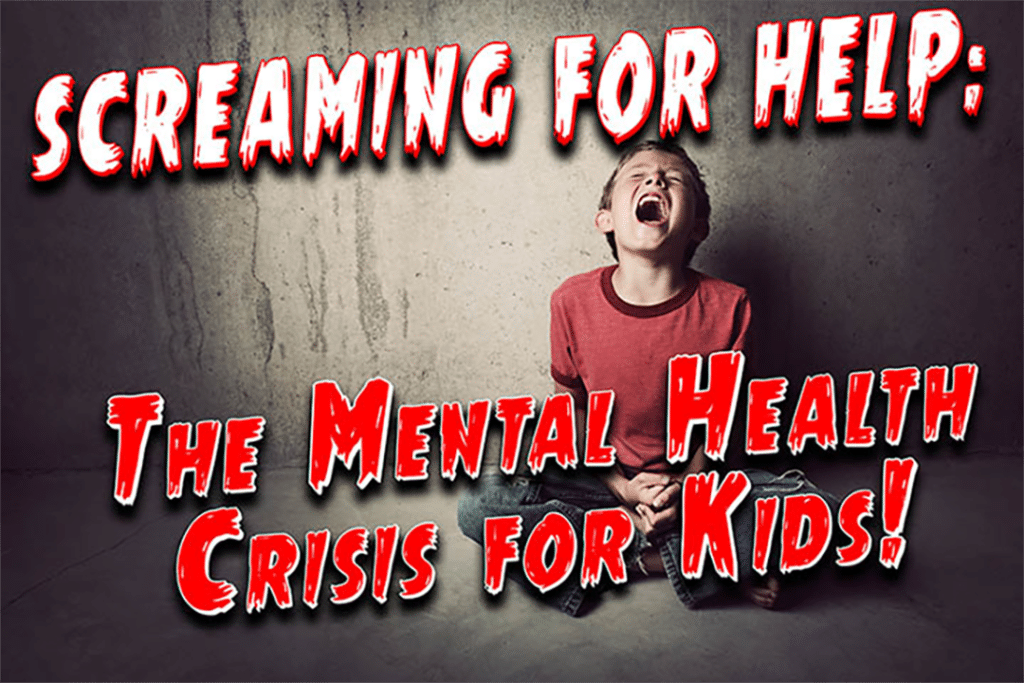While I was writing my 27th novel, Facing the Beast Within: The Anxiety of Cameron Poole, I learned a number of disturbing things about the mental health of our children in this country. I wanted to share this with you, for I think it’s important.
As we all know, a child’s mental health is crucial for their overall well-being.
It significantly impacts every aspect of their lives. But mental health challenges, such as anxiety, depression, loneliness, isolation, and self-esteem disorders, can have a huge negative impact on our kids. Kids with mental health issues typically struggle in school and relationships and are more likely to engage in self-harm and risky behaviors. Some may even have thoughts of suicide or engage in suicidal behavior. Pediatricians warn that the childhood mental health crisis has become a national emergency [1]. Anxiety and depression affect more kids and teenagers than ever.
As a physicist, I like numbers, so here you go:
Mental Health Data: Youth Anxiety Statistics
-
-
- Around 6% of children in the United States aged 6 to 17 face significant emotional or behavioral challenges [2]. This includes kids diagnosed with severe anxiety, depression, ADHD, autism, behavior issues, and trauma-related mental health problems.
- Some conditions often coexist. Data shows that in 3–to 17-year-olds with anxiety, there is a higher prevalence of behavior issues (37.9%) and depression (32.3%).
- Anxiety and depression have increased for kids and teens over time. In 2018–2019, 36% of 12–17-year-olds felt depressed or hopeless. This ratio rose to 44% in the same age group following the pandemic. Cigna’s research also raises severe concerns about loneliness [3]. Think about that for a minute – if you’re a teacher, almost half of your students are depressed or feel helpless!
-
The Impact of COVID-19 on Kids’ Mental Health
Of course, we all know the pandemic amplified the problem. With constant zoom sessions, cameras not working, wifi connectivity being spotty and myriad of technical challenge with didn’t need, trying to keep our kids engaged in school and learning without us going crazy was a significant challenge.
The combination of remote learning and limited social interaction negatively impacted the mental well-being of millions of youth nationwide [4].
Children experienced disruptions in their daily routines and social lives, along with uncertainty surrounding the virus, illness, and death in the family. These experiences have impeded some kids’ social-emotional development, leaving them isolated and suffering from increased stress, anxiety, and depression.
For us parents and caregivers, our mental health took a hit as well during the pandemic, which didn’t help our kids. According to the data, one in every twelve children lived with someone suffering from a mental illness in 2020, a 5.5 percent rise from 2016 [5].
Over 200,000 children are believed to have lost a parent or primary caregiver due to COVID-19 [6].
COVID was not the only obstacle to helping our kids’ mental health. There were numerous factors in play before and after the pandemic that contributed to the mental health crisis for our kids. Here are some of them.
Access to Mental Health Services for Kids
Many children with mental health issues experience long waits for professional help, often spending over six months on a waiting list for mental health support. Rural communities are particularly hard hit, as these areas have limited or no mental health professionals trained to treat children. Additionally, most children from low-income families may not have insurance and are forced to pay for mental health treatment out of pocket.
Shortage of Child Psychologists
If you’ve recently searched for a therapist for your child, I’m sure you’ve found what many have discovered . . . no one is taking new patients, right? Because of the mental health crisis, therapists are at capacity and don’t have any room left in their schedules. According to the Kaiser Family Foundation,
47% of the US population in 2022 was living in a mental health workforce shortage area [7].
There are several reasons for the shortage of child psychologists and the relatively low number of individuals entering the field, such as the following:
-
- Lengthy and expensive education
- Rigorous licensing and certification requirements
- Administrative burdens
- Stress and burnout related to the profession
Mental Illness Stigma
Children would benefit from discussing their mental health problems openly with their families, friends, and the larger community. However, kids with mental health issues often face bullying, prejudice, and discrimination as a result of their condition. This often deters them from seeking help.
Instead of seeking professional help, many young people with mental health conditions choose to keep their challenges to themselves. Many turn to self-medication, substances, food, and isolating themselves from their community as coping mechanisms.
Conclusion
So, what’s my point . . . right? I wish I had some solution, but I don’t. I can’t give you any advice on how to help your child because I’m not a psychologist or mental health professional. Sure, I wrote a fantasy novel to help kids with anxiety, but that’s not the same thing as going to a therapist, which is a much better solution.
I know social media doesn’t help with this crisis. Other than giving you information about anxiety and other mental health challenges, I’d say social media is part of the problem. There are numerous examples of the negative impact social media has on our kids’ mental health [8] but removing social media from our kids’ lives is probably impossible.
I don’t have an answer, so, I wrote my 27th book, FACING THE BEAST WITHIN; THE ANXIETY OF CAMERON POOLE. I’m hoping it will give kids a little hope. Maybe the anxiety coping strategies the team of child psychologists shared with me can reinforce what a child is hearing from their therapist. Maybe Facing the Beast Within gives a parent the opportunity to talk about panic attacks by focusing on Cameron instead of their child’s difficulties; that is likely a much less threatening discussion. Maybe it helps . . . a little, I’m keeping my fingers crossed.
In the next post, I’ll tell you about some of the things the government is doing to address the problem.
- https://www.apa.org/monitor/2023/01/trends-improving-youth-mental-health
- https://www.cdc.gov/mmwr/volumes/71/su/su7102a1.htm
- https://www.ncbi.nlm.nih.gov/pmc/articles/PMC7321652/
- https://ccf.georgetown.edu/2022/03/24/research-update-childrens-anxiety-and-depression-on-the-rise/
- https://www.ncbi.nlm.nih.gov/pmc/articles/PMC10009501/
- https://www.apa.org/monitor/2022/10/kids-covid-grief
- https://www.kff.org/other/state-indicator/mental-health-care-health-professional-shortage-areas-hpsas
- https://www.center4research.org/social-media-affects-mental-health/

Read the early chapters of Boys Adrift describing how boys are at a disadvantage in the first year of school for reading. Reading skills lag throughout until 12 grade where boys are years behind girls. It leads to dropouts, crime, drug use, and is a large reason why boys and men are mentally struggling.
And the common refrain is to step up, msn up, pull yourself up by your bootstraps for failing boys.
There s no positive message from school staff, policy or teachers to boys, only don’t , quit, stop misbehaving, etc.
My now high school sons struggled with rather lack of support from the school, and especially when the girls had nothing but affirmation praise and girl only pizza parties at school. My boys were dreading school and being bullied by girls who knew they didn’t face any punishment for the bullying since, no one would believe the boys.
Boys are struggling yet no one does anything except talk about it. No government programs specifically for boys, no state panel on boys, no White House panel on boys.
I had difficulty finding boy friendly books for my sons, where boys are not negatively stereotyped, made the butt of jokes, etc. basic positive boy messages, booys growing, achieving feats, and not social conditioning them to only see self worth in self sacrifice or being an ally.
The hardest lesson adds a gen x dad was finding that I had value innately and the value did not depend on what I did, my job, my money, how beautiful my wife is, etc.
Ypthose we’re all social conditioning to get me to achieve money just to support a family. Hence, the follow on of society see me as a human I only what I could provide.
That message was not passed down to my boys. They have self worth by just being born. It is the same message taught to girls by society.
My boys would get bullied by girls, kixcked, hit by girls and then told by the teacher to respect and open doors for those same girls.
The girls would plan out which boy to bully on the playground. My sons overheard them multiple times.
My youngest son read every book of yours he could and loved them.
His reading complaint was that there needed to be more books from you to red.
My older son stated that school always made him act like a girl and broke taught girl things. He wanted more school time spent on boy things, including adventure stories, with action ispnstead of always talking in the girl stories.
My observations,
Girls need to be taught to respect boys and that boys have feelings too,
Boy friendly academics need to be taught in school, for example, not turning science assignments into art projects,
Busy work should be minimized in school as it favors students who sit quietly, conform and agree. It deadens children asking open ended questions since busy work takes up all the class time. Open ended questions are not trying to show off or disrupt the class, they are asked from a genuine interest and curiosity.
Boys, my boys too, saw repeatedly favoritism for girls at school. By high school the both mostly avoided girls after years of school staff ignoring girls bullying boys
Lastly, my younger son has adhd and hated reading, Minecraft novels helped him to learn to love reading. I told him that I would pay one penny for every three pages thread. He had to read the story, even below grade level books counted, write the title, author name page count and divide it by three.
He also needed motivation to read no motivation to do math.
Divide by three is uncommon and for a fourth grader is not something he could estimate.
I know That he has read 5000 or more pages from fourth to tenth grade.
By reading, getting money to buy books, and basic math he gained confidence in school.
I didn’t know any of this beforehand. Made it up along the way.
The Boys Adrift book and the Sold a Story podcast both have it right. Reading Proficiency needs to be at grade level or above in pre k to help our boys especially and girls too.
Please feel free to use this comment without attribution or mentioning any name or identifying characteristics. Sorry about misspelling and etc, phones are not the best for long messages.
P.s. he really liked Hatchet and Holes, by other authors. He tried but gave up on the Outsiders even with many historical context discussions I had with him about the times back then.
He identified quite with books having a diary entry, self introspection thought at the beginning of a chapter. He at age ten said they were like a thing to learn for life.
My wife tried hundreds of hours and lots of fellow mom suggested ways to get son to achieve in school. I found out that shoulder to shoulder shared experience working on a common problem with a male worked.
My dad did that, I had forgotten. Work side by side and when son was ready, he would open up and talk. Therapy?
So now I read a novel, paper version, no screens, at the table when he is struggling with homework and motivation.
I started doing that when he would cry in third grade when he had three hours of homework each day. ADHD was making it take longer and longer.
Teachers piled on busy work which put adhd son further and further behind. Making his grades lower and making him believe he was a failure.
I appreciate your stories. Help our boys to read.